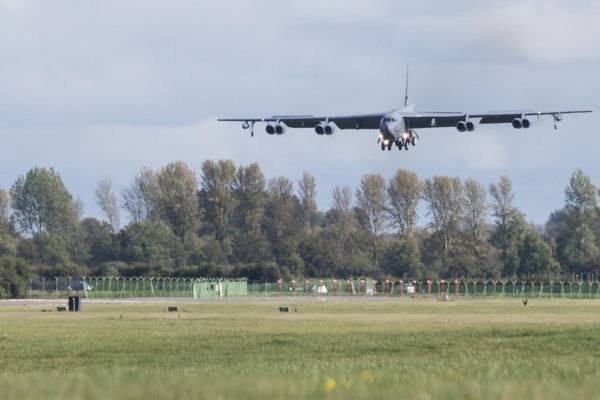Many people have heard of the iconic B-52 strategic bomber of the United States Air Force, which has been in service for nearly 70 years and has long been the backbone of the USAF’s striking capabilities, exuding significant deterrence. But perhaps few are aware that this bomber has wheels near its wingtips, a feature that sets it apart from other military aircraft. Why is that?
According to aviation news website “Simple Flying,” the B-52 is designed to provide close air support and conduct interdiction missions, being a long-range heavy bomber. It can fly at high subsonic speeds (0.84 Mach) at an altitude of 50,000 feet (15,160 meters), carrying both conventional and nuclear weapons with global precision navigation capabilities.
In a non-refueled scenario, the B-52 bomber can fly up to 8,800 miles (14,162 kilometers) due to its large fuel tanks, which can be filled up to the wingtips. It is capable of carrying weapons weighing up to 70,000 pounds (31,500 kilograms), including bombs and missiles.
Developed by Boeing, the B-52 bomber entered service in 1955 and has been in operation for nearly 70 years. The United States Air Force plans to keep the aircraft in service until 2050, surpassing a service life of over 90 years by then.
The design of the B-52 bomber is unique, especially with the presence of wheels under each wingtip, known as wingtip landing gear, that differ from the main landing gear.
The wingtip landing gear supports the weight of the 185-foot (56.3 meters) wingspan and the fuel carried within the wings. Depending on the amount of fuel stored in the wings, the wingtips can flex downward by 10 to 12 feet (3 to 3.7 meters), requiring sufficient structural support.
During taxiing, takeoff, and landing, the wingtip landing gear of the B-52 bomber prevents the heavy wings from bending downward on the ground. However, a drawback is the need for a wider runway and taxiway to provide adequate support. On narrower runways, the wingtip landing gear may scrape against the grass on the runway edges.
The U.S. Air & Space Forces Magazine once quoted former B-52 bomber pilot Dave Prakash, stating, “Other aircraft can extend their wings over grass without a problem. But we have wingtip landing gear that needs the runway to touch the ground.”
On July 16, 2023, a U.S. Air Force B-52 bomber conducting routine taxiing at an airbase in the UK had its wingtip wheels hit runway lights. As the taxiway was narrow, the wingtip wheels nearly dragged on the grass and collided with the runway lights.
The B-52 bomber’s landing gear can rotate 20 degrees left or right for safe crosswind landings. The wheels of the landing gear can also assist in moving the aircraft crabwise if necessary. When operating on a narrow runway, pilots can choose which side’s wingtip wheels to suspend in the air.
To achieve this, pilots can transfer fuel from one wing to the other, making one side heavier and in need of wingtip wheel support while keeping the other side’s wingtip wheel lighter and suspended in the air, enabling operations on narrow runways.
Having advance knowledge of the runway size allows pilots to plan ahead, ensuring enough space for safe ground operations. In certain circumstances, ground personnel can guide the aircraft onto taxiways (or runways) to prevent collisions with airport lights.

